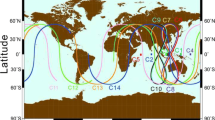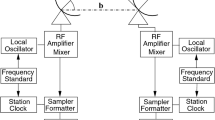Abstract.
The present contribution is the first of four parts. It considers the precision of the floated and the fixed baseline. A measure is introduced for the gain in baseline precision which is experienced when the carrier phase double-differenced ambiguities are treated as integers instead of as reals. The properties of this measure are analyzed, and it is shown by means of principal angles how it relates to the change over time of the relative receiver-satellite geometry. We also present canonical forms of the baseline variance matrices for different measurement scenarios. These canonical forms make the relation between the various variance matrices transparent and thus present a simple way of studying their relative merits.
Similar content being viewed by others
Author information
Authors and Affiliations
Additional information
Received: 16 July 1996; Accepted: 14 November 1996
Rights and permissions
About this article
Cite this article
Teunissen, P. A canonical theory for short GPS baselines. Part I: The baseline precision. Journal of Geodesy 71, 320–336 (1997). https://doi.org/10.1007/s001900050100
Issue Date:
DOI: https://doi.org/10.1007/s001900050100




